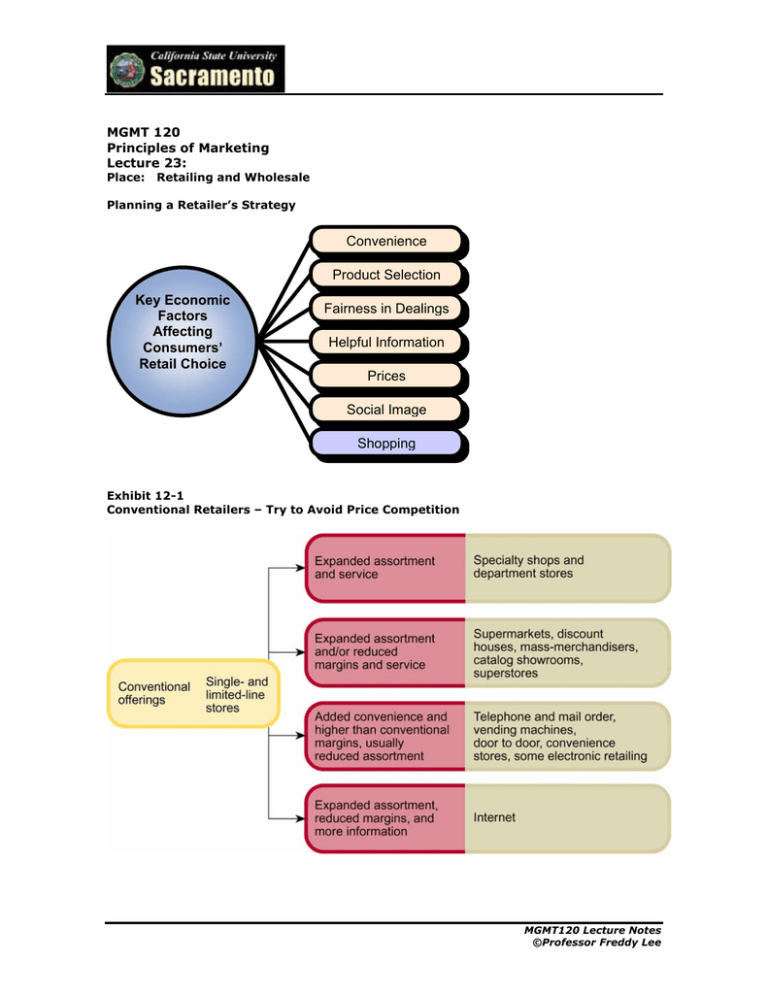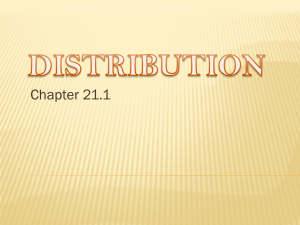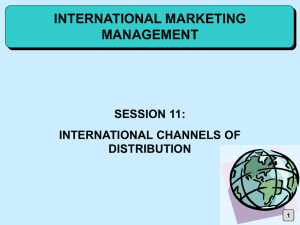Document 10301831
advertisement

MGMT 120 Principles of Marketing Lecture 23: Place: Retailing and Wholesale Planning a Retailer’s Strategy Convenience Product Selection Key Economic Factors Affecting Consumers’ Retail Choice Fairness in Dealings Helpful Information Prices Social Image Shopping Exhibit 12-1 Conventional Retailers – Try to Avoid Price Competition MGMT120 Lecture Notes ©Professor Freddy Lee Store Retailing • Retail stores • Classification based on – All shapes and sizes – Location, location, location! – Amount of service – Product line – Relative price – Control of outlets Amount of Service • • • Self-service retailers Limited-service retailers Full-service retailers • Classify these stores Product Line • • • Classified by the width and depth of their product assortment Six types of assortments Specialty stores carry a narrow product line with a deep assortment within that line. 2. Department stores • Carry a wide array of lines, typically clothing, home furnishing, and household goods, with each line operated as a separate department. 3. Supermarkets • • • Large, high-volume, self-service stores that carry a wide variety of food, laundry, and household products. Most are owned by chains. Practice “scrambled merchandising” Specialty stores Department stores “designer shops” Discounters sales promotion MGMT120 Lecture Notes ©Professor Freddy Lee 4. Convenience stores • • • • • Carry a limited line of high-turnover convenience products Location Business hours An increasing range of products and services Some goes “upscale” 5. Superstores • Much larger than regular supermarkets, and carry a large assortment of routinely purchased food and nonfood items. • Category killers – A hybrid of superstore and specialty stores. – A wide assortment of a particular line with a knowledgeable staff. • Hypermarkets – Mega-, huge superstores. 6. Service Retailers • • Hotels, motels, banks, airlines, movie, theatres, … Grows faster than product retailers. Relative Prices • Most retailers – Normal price, normal quality goods and service – Higher price, higher quality goods and service • “Low price” retailers – Discount stores • Standard merchandise at lower price • Lower margins and higher volume – Off-price Retailers • Factory outlets • Warehouse (or wholesale) clubs Control of Outlets • Independent, owner-operated stores • Chains – Over 20% of US retailers belong to some type of chain. – In the grocery sector, 65% of the market is controlled by chains. Corporate Chains An organization operating four or more retail outlets in the same kind of business, under the same legal ownership. Statistics Canada MGMT120 Lecture Notes ©Professor Freddy Lee Voluntary Chains Wholesaler-sponsored voluntary groups of independent retailers that engage in group buying and common merchandising. Independent Grocers' Alliance Retail Cooperatives Group of independent retailers who set up a central buying organization and conduct joint promotion. e.g., Home Hardware, Mountain Equipment Co-op. Franchise • A contract between a manufacturer, wholesaler, or service organization (the franchiser) and independent businesspeople (the franchisee) who buy the right to own and operate one or more units in the franchise system. • Many of them, and still increasing: – – – – Ford dealers McDonald’s 7-Eleven … Non-Store Retailing • • • Direct marketing – Direct mail – Catalogue selling – Television retailing – On-line shopping Direct selling (door-to-door) Automatic vending Direct Marketing Provides Coverage MGMT120 Lecture Notes ©Professor Freddy Lee Exhibit 12-2 Online vs. In-Store Shopping Retailer Marketing Decisions Retailer Marketing Mix Retailer Strategy Seven Ps - Target market - Retail positioning Product assortment and quality Price Place Promotion Personalized services Physical facilities Personnel MGMT120 Lecture Notes ©Professor Freddy Lee Trends of Retailing • • • • • • People, Financial and Technology management Increasing intertype competition Growth of non-store retailing The rise of global mega-retailers Fast-changing retail technology Retail stores as “communities” or “hangouts” Why Retailers Evolve and Change AND Scrambled Merchandising = Higher Profits Product Life Cycle Applies to Retailing Ethical Issues May Arise Exhibit 12-4 Wholesaling and Wholesalers MGMT120 Lecture Notes ©Professor Freddy Lee • • Wholesaling includes all activities involved in selling goods and services to those buying for resale or business use. (Costco??) Major wholesaler types Wholesalers Defined • Merchant wholesalers take title to the merchandise they handle • Brokers and agents do not take title to goods • Manufacturers’ branches and offices – Brokers brings buyers and sellers together and assist in negotiation. – Agents represent buyers or sellers on a relatively permanent basis. Exhibit 12-6 Types of Wholesalers What Will Happen to Retailers & Wholesalers in the Future? MGMT120 Lecture Notes ©Professor Freddy Lee Improved Logistics Efficiency Increasing Competition New Internet Applications Marketers & Consumers Can Expect To See! Development of Specialized Intermediarie New Web-Based Retailers MGMT120 Lecture Notes ©Professor Freddy Lee






